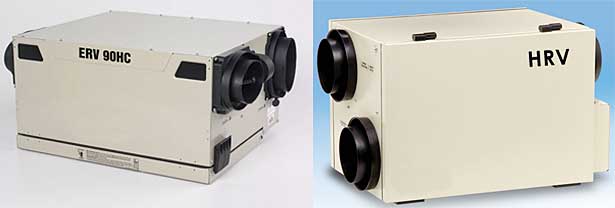Underground Home Ventilation
When you build an underground home, there are few things more
important than adequate ventilation. Otherwise, you may be exposed
to excess CO2 and suffer a lack of oxygen. The use of an energy-recovery
ventilator, also known as an ERV, or a heat-recovery ventilator,
also known as an HRV, is of vital importance in underground homes.

Converted Underground Missile Silo Home |
Most builders of earth homes will choose
a central fan-integrated system, an exhaust-only system
or a balanced ventilation system that uses an ERV or a HRV
for proper ventilation.
|
A balanced ventilation system is not cheaply installed, but they
do offer you a reasonable cost of operation, compared to any other
ventilation systems.
An ERV or HRV delivers fresh air to the interior of your home.
Neither one was designed to make up for kitchen or bath exhaust
fans or combustion appliances. They are not designed to heat your
home. They both use electrical energy in order to operate their
fans. In addition, they may lose cooling or heating energy since
they are moving heated or cooled air from your home.
HRV fans will pull fresh air into your home while they exhaust
the stale air. Usually, the fresh air is brought into the bedrooms
and living room, and stale air is pulled from the laundry and
bathrooms. Both types of air will stream through your HRV. In
addition, the appliance core will allow some of the heat from
the stream of warmer air to transfer to the air stream that is
cooler. By this method, the system can recover some heat before
it is expelled from your house.
ERV or HRV - Huh?
An ERV will accomplish the same things as an HRV. Additionally,
the ERV will allow some moisture in the humid air stream to transfer
to the dryer air stream. Transferring this moisture does not mean
that much of the two air streams is mixed.

Underground homes have more need of ventilation than conventional
homes. ERV's or HRV's can provide fresh air for your health, remove
any odors from your home, lower indoor humidity and dilute pollutants
from your indoor air. Using proper ventilation, you can keep your
home's air fresh and healthy for you and your family.
When you are ventilating your home, the system should account
for the fact that lower humidity is better than high humidity.
But proper ventilation can only reduce the indoor humidity if
the air outside is dryer than the air indoors. Colder air isn't
as humid as warmer air, so the only time a ventilation system
will help in lowering your indoor humidity is when the weather
outside is cold. When you ventilate your home in hot weather,
it may even raise the humidity level.
Choosing between ERV's and HRV's does not depend only on climate.
You can use ERV's in cold climates, contrary to HRV sellers' claims,
and in humid climates, an ERV won't act like a dehumidifier, as
their sellers sometimes claim.
When your HRV or ERV works to ventilate your air-conditioned
house, the air coming in is cooled by the air going out. This
only works if your house is air conditioned, though. If your inside
air is warm, too, there isn't much heat exchange.
I'm Venting!
Whether you use an ERV or HRV, you'll be satisfying your underground
home's need for proper ventilation in every season, even though
they do have their minor downfalls.
|

